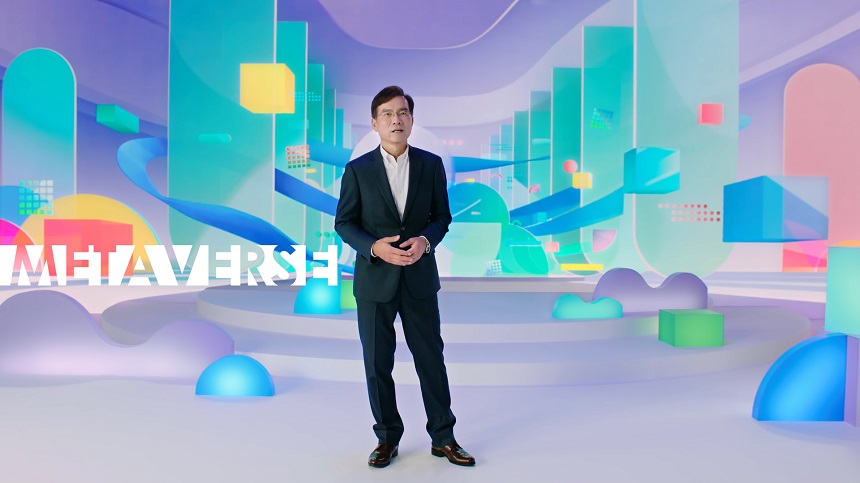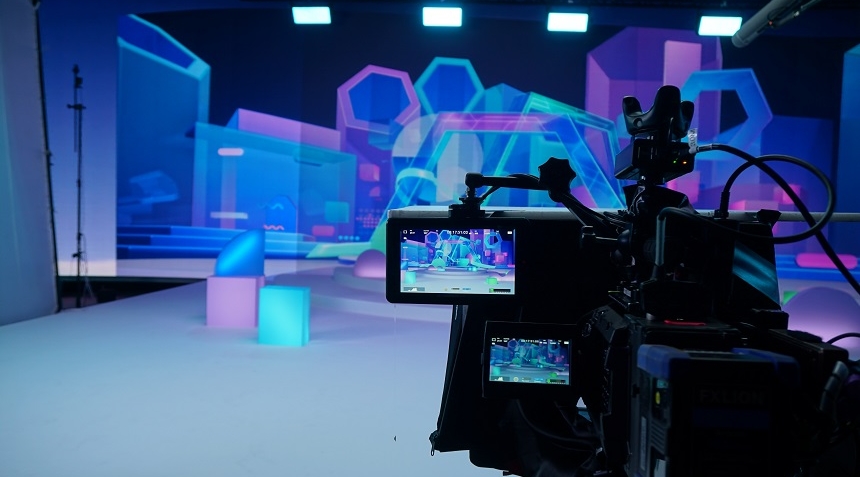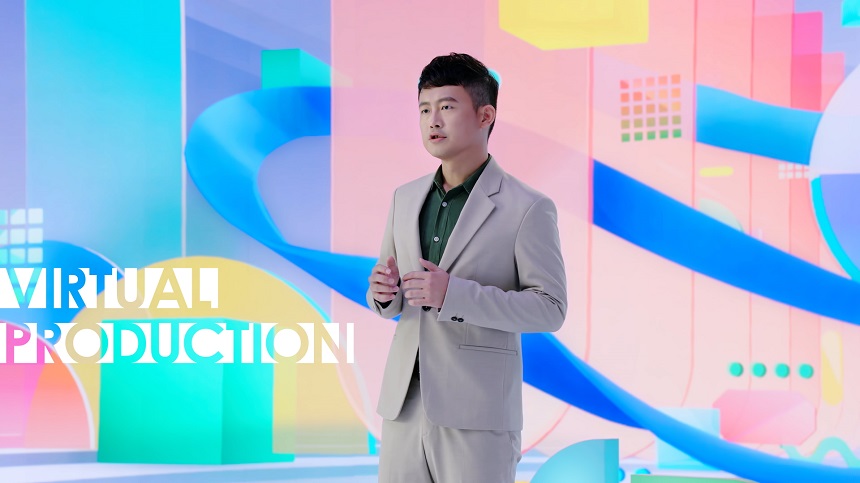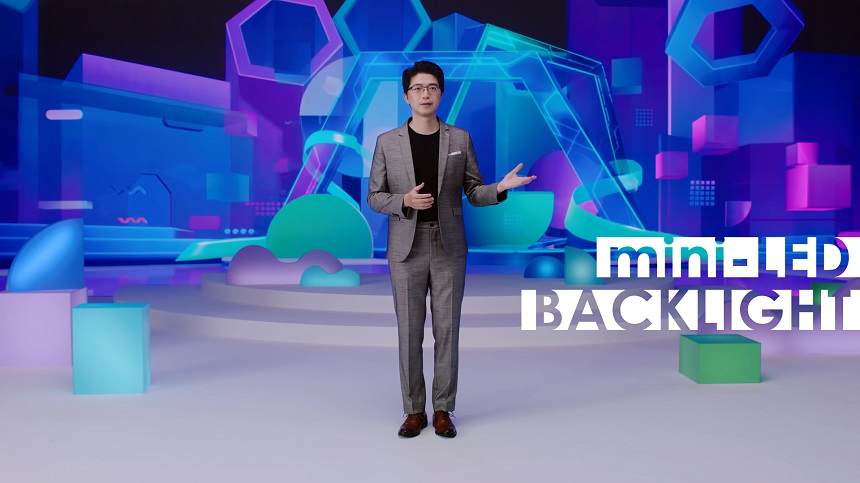CLOSE
Search for “” keywords, total search results
CLOSE
Search for “” keywords, total search results
2021.December





Macroblock Symposium 2021 was held online on December 15. Through cooperation with Moonshine Animation, we used XR shooting techniques in the virtual production studio to create a new symposium style. This virtual studio created a variety of scenes according to the shooting purposes. When using "Camera Tracking," the scenes moved with the speakers to generate a highly immersive visual experience that blurred the boundaries between the virtual world and reality. It was a concrete demonstration of the in-demand virtual reality application in the LED display industry during the post-epidemic period.
Innovative XR style symposium
Macroblock's General Manager Mr. Robert Chen acted as a film director in the opening. He inspected the key elements of an XR studio, such as the console, camera, and virtual scenes. He led the audience onto Macroblock's magical XR stage to understand the outstanding features of an XR studio within 60 seconds. Mr. Robert Chen highlighted that the theme this year was derived from the mathematical concept "union". Stating the equation of "micro-LED ∪ mini-LED ∪ LED Display ∪ LCD = Macroblock," Macroblock wanted to deliver the message that its driver IC products cover a full range of display applications. On top of that, speakers explored in-depth the display field together with the audience by sharing market trends, cutting-edge technologies, and new product information in the LIVE symposium.
Tailored made for virtual production | 120Hz frame rate, 16-bit grayscale, 7,680Hz visual refresh rate
Virtual production-extended reality (XR) is widely used in commercials, MVs, and film shooting, Mr. Cloud Wu, the product manager of Macroblock mentioned. Additionally, he stressed that the key to good virtual production work is the cooperation between cameras and LED displays, which brings a true-to-life background. Cloud made two conclusions about the application requirements for optimal results. First, the pixel pitch of virtual production LED displays is from P1.5(for close-up shots) to P2.8(for distant shots, as a backdrop). Also, the ideal brightness should be 2,000 nits to optimize visual performance and achieve peak brightness of scenes (HDR source). Therefore, in terms of the driver IC selection, a 16-scan design is the best solution to balance the brightness requirement and picture quality at the same time. Second, the shooting format should be the multiples of the LED display's frame rate. LED display controller's "Genlock" could help achieve synchronization. That is the foundation of flawless shooting.
In fact, even though cameras synchronize with LED displays, users may still face 3 challenges: motion blur, scan lines, and flicker caused by low refresh rate at a low grayscale level. These visual problems can be improved by employing the next-generation, tailor-made virtual production driver IC. This latest driver has a "PWM Enhancement +" function that can realize 16-bit grayscale, 120Hz high frame rate, and 7,680Hz visual refresh rate. "PWM Enhancement +" is the critical solution for eliminating motion blur and easing scan line problems. Moreover, the unique "Hyper Vision Calculation" of the driver IC can fix flickers at the low grayscale and further reduce the split-screen effect caused by the scan line issue. Solving all three image challenges achieves the goal of having flawless shooting and brings an overall better immersive experience.
The breakthrough of high-scan design | Optimize uniformity at low grayscale to boost HDR-Optimized performance
Over the years fine-pitch LED display applications moved ever closer to the consumer from the commercial market. In the past, advertising digital billboards accounted for the majority of applications involving a viewing distance farther than 10 meters. However, innovations in the technology have shortened viewing distances and expanded the scope of applications, such as All in One (AIO) LED displays (P1.2~P2.5; SMD LED), home theaters (P1.2~P0.5; mini-LED), and automotive displays (finer than P0.5; micro-LED). Mr. Hung-I Cheng, product manager of Macroblock analyzed the connectivity between the five technical thresholds behind the applications and the requirements for LED driver ICs. First, the smaller the LED chip size, the more precise the LED current. Second, choosing between "face-up LEDs" or "flip-chip LEDs." Third, deciding when to use "Pick and Place" or "Mass Transfer" technology. Fourth, selecting suitable substrates based on the targeted pixel pitch. Fifth, the number of PCB layers must be directly relative to how many scans that driver IC can support. More PCB layers mean higher production costs. Therefore, we can understand that the shrinking pixel pitch of LED displays increases the production and related costs. The high-cost structure of the current LED displays may lead to a lower consumer market penetration rate. Macroblock has the solution for mitigating cost pressure and is proud to announce the launch of a new 96-scan driver IC-MBI5265.
MBI5265 can support up to 96 scans. It also decreases driver IC counts by 67% compared to the 32-scan driver ICs. On top of that, MBI5265 has embedded a "PWM Enhancement" function and a "Grayscale Boost" function that help realize HDR-Optimized performance (16-bit | 3,840Hz) for a 96-scan design.
Although the specification of HDR-Optimized is fantastic, we find it necessary to improve uniformity at low grayscale to increase picture quality. This is because non-uniformity problems, such as color blocks, vertical stripes, and horizontal stripes result in low contrast and poor visual performance. Now, color blocks and vertical stripes can be mitigated by the high precise channel current and timing function control. Nevertheless, when increasing the scan number of an LED display, PCB routing may cause horizontal stripes to occur on the display due to the inconsistent current of each scan. Now, thanks to having "Uniformity Driving," MBI5265 can minimize horizontal stripes perfectly, rendering the best visual performance at low grayscale.
Highly-integrated mini-/micro-LED driver ICs | A P0.4 successful case
Due to the limited backplane space of mini-/micro-LED applications, how to increase space utilization and deliver finer pixel pitch solutions are the main concerns. Therefore, in terms of the LED driver IC, its features should include high integration, high scans, and use a scan-sharing scheme to meet the demands of today's market. MBI5864 is a highly integrated driver IC that can support up to a 64-scan design and achieve HDR-Optimized (16-bit | 3840Hz). Mr. Hung-I Cheng showed the P0.4 mini-LED module using an MBI5864 with the BGA package to prove there is still enough space on the backplane. Also, the contrast rate is 25,000:1. As for the operation temperature, we found a near-consistent 35℃ on the front and back sides of the mini-LED board. It can prevent overheating caused by long time operation and the "cyan blocks" visual problem.
Upgrade visual experience of gaming displays | Full Array Local Dimming (FALD) mini-LED backlight driver IC with variable refresh rate (VRR) technology
When it comes to gaming display panels, high picture quality and high contrast rate are the "must-haves" for gamers. Additionally, it is necessary to have a variable refresh rate to cope with the varying frame rate generated by the GPU. The VRR function can reduce gamers' unacceptable visual problems, such as "tearing" and "stutter."
Mr. Chris Will Chen, the product manager of Macroblock mentioned the fact that many gaming display panels are equipped with FALD mini-LED backlight. This differs from a traditional backlight solution, "Picturization" is why the FALD mini-LED backlight can realize HDR and local dimming. When the mini-LED backlight does not have VRR, the LCD will suffer from "flicker" or "uneven brightness." This seriously impacts the user experience for gamers. Therefore, Macroblock launched a series of new FALD mini-LED backlight driver ICs: MBI6329, MBI6353, and MBI6334 that are embedded with the VRR function. Regardless of whether it's a static or scan-type mini-LED backlight LCD, driver ICs can cope with Vsync. and mismatched frame rates to bring the ultimate visual experience to gamers.
Macroblock 2021 online symposium used avant-garde XR technology that blended real and unreal scenes all together to create an immersive and stylish symposium for audiences.
To recap the symposium and LIVE Q&A, please click on the following link: https://www.youtube.com/watch?v=0mn-_zqULAM